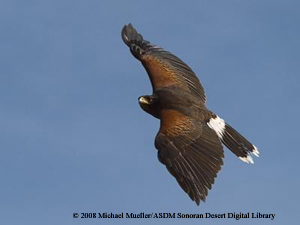Animal Fact Sheet: Harris's Hawk |
Identifying Features Harris's hawks (Parabuteo unicinctus) are dark brown in color with copper or reddish colored shoulder patches. Their tail is long with white feathers near the vent and at the tip of the tail. When in flight the underside of the wings are also coppery in color. Their legs are long and yellow and their beak has a yellow base and black tip. |
 |
Adaptations These birds are one of only two known raptor species that hunt as a group. This cooperative hunting style works much like those of mammals, where some members of the group flush out the prey and chase it towards the other hunters in the group. Harris's hawks have excellent vision, possibly 8 times greater than human vision. |
Habitat These hawks are found in semiarid habitats such as mesquite and saguaro deserts as well as canyons, chaparrals and scrub land. |
Range They are widely distributed from much of the US-Mexico border area, south into Mexico and Central America, and dry habitats of South America. |
Wild Status They are not currently listed as threatened or endangered. They are protected from being harassed or hunted by the Migratory Bird Treaty Act. |
Diet Harris's hawks are carnivores and prey on rabbits, rodents, other birds and lizards. |
Predators Because these birds build their nests high off the ground in saguaro cactus or trees it is difficult for many predators to reach them. They will also use group members to help protect the nest from predators by giving alarm calls or harassing any animals who threatens their nest. Predators can include great horned owls, coyotes, common ravens, and bobcats. |
Home They build nests made of sticks, dried weeds, grasses, and twigs in cacti, trees, bushes or man-made structures. The 2-4 eggs will be incubated for 32-26 days. |
Life Span Harris's hawks can live to be between 15 and 20 years old. |
Size The Harris's hawk is generally 18-24 inches in body length, has a wingspan of 3-4 feet and weighs 1.5-2.5 pounds. Female hawks are larger than the males. |
Extra Fun-facts
|
 ©Copyright 2008, Arizona-Sonora Desert Museum
©Copyright 2008, Arizona-Sonora Desert Museum